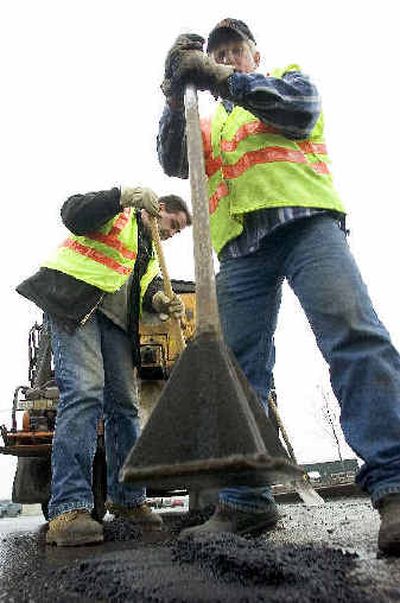City crews begin patching potholes

This week’s rapid thaw unleashed an inevitable hazard in Spokane streets: the annual opening of potholes.
Two crews were dispatched across the city this week to make temporary repairs to numerous new potholes, and city officials said the problem was not unexpected.
“I don’t think this is any worse than past years,” said Scott Egger, director of streets for the city.
He said the worn and cracked condition of many arterials, such as North Wall and North Crestline streets, leads to the problem.
Voter approval last fall of a $117 million street improvement bond will allow the city to permanently eliminate many of the city’s worst potholes, but it will take 10 years to get work done on nearly 110 miles of city streets.
“Slowly, these roads that do have potholes will disappear,” Egger said.
Spokane may eventually become like Coeur d’Alene, where there are so few problem areas that crews are keeping potholes in check, said Jon Ingalls, street superintendent in Coeur d’Alene.
“I’m pretty pleased with the way the roads are holding up this year,” Ingalls said.
By contrast, many of Spokane’s older arterials were built with 3 or 4 inches of asphalt on top of sand bases. City officials said reconstruction under the voter bond issue will include excavation of road beds and installation of crushed rock below asphalt driving surfaces. The rock helps prevent soft subsurface spots that lead to potholes, Egger said.
Worn streets are particularly susceptible to potholes because moisture seeps through cracks and saturates the sandy substructure. The water freezes and expands during winter, setting the stage for potholes once the ice thaws and releases the broken pavement that’s constantly under pressure from passing vehicles, Egger said.
Spokane’s climate also aggravates the problem because it is prone to repeated freezes and thaws throughout the winter. Often, temperatures go through freeze-thaw cycles daily, Egger said.
Pothole patches in the winter are considered temporary repairs. Crews will have to return to each pothole in the summer after the road dries out for a more permanent repair.
City crews have also been working this week to open storm drains, spread sand on icy hills and eliminate snow piles downtown, Egger said.